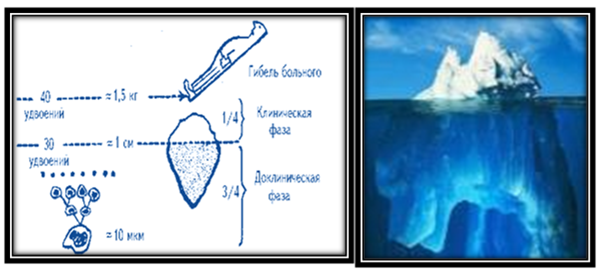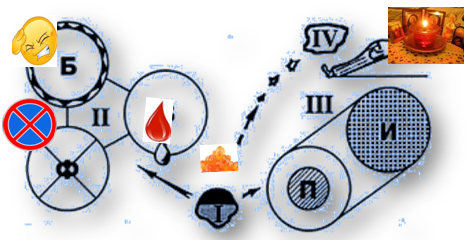MOJ
eISSN: 2641-9300


Mini Review Volume 1 Issue 4
Institute of Medical Education, Oncology course Novgorod University Yaroslav the Wise, Russia
Correspondence: Cherenkov VG, Institute of Medical Education, Oncology course Novgorod University Yaroslav the Wise, Russia
Received: July 24, 2018 | Published: August 7, 2018
Citation: Cherenkov VG, Makarov VA, Petrov AB, et al. Ways of creating artificial intellecte in education and carrying out cancer component of medical examination (screening) of the population. MOJ Tumor Res . 2018;1(4):136-138. DOI: 10.15406/mojtr.2018.01.00031
Malignant neoplasm (МN) diagnosis is an urgent problem of the modern world. The proportion of advanced forms remains high-an average of 25%, and one - year mortality-even higher. First of all, early diagnosis depends on General practitioners. The doctor should carry out a systematic examination of the patient not when something is "sick", but regularly, when nothing hurts, taking into account risk groups, gender and age. When mass screening asymptomatic signs of dysplasia or early focus of developing cancer requires optimization of analysis and examination algorithms, which is not always possible for one person. Previously created computer technologies such as Watson Health," Edifar" and others are mainly aimed at choosing the best treatments and General medical and social health issues.
However, the problem of early diagnosis, in which treatment is less difficult. Based on the analysis of the patterns of tumor growth, ¾ of which is in the preclinical phase, as an "iceberg in the ocean", direct and indirect manifestations of Cancer, we have identified four groups of supporting (pathogenetic) symptoms. The application of the system "the Vote" with a set of panels and we have developed an interactive program "Oncology” test of the control elements of the visualization is able to certify students and doctors. To conduct classes with visual perception and to carry out an objective and transparent control of knowledge for the participants is the first step. Subsequent and final steps require the creation of such a class of tasks and artificial intelligence systems. Without a software system that includes the fundamental knowledge of specialists, providing advice to less trained users, with a high degree of reliability is not possible. We present the system of such robotic technologies in our work.
Keywords: early cancer diagnosis, supporting symptom, computer technologies
Every year, up to 10 million new cases of cancer are registered in the world, more than half of which die within a year. Cancer diagnosis is an urgent problem of the modern world, despite the rapid development of medicine. The proportion of advanced forms of MN remains high-an average of 25%, and one - year mortality-even higher. The main problem of modern Oncology is the lack of correspondence between the achievements of medical science and technology, allowing using biological markers and screening tests (cytological, genetic, x-ray, ultrasound and et. methods, to detect cancer at a stage when treatment can be achieved in 80-100% of cases.1 On the other hand, the lack of understanding that the doctor should carry out a systematic examination of the patient not when something is "sick", but regularly, at least once a year, when nothing hurts, taking into account the risk groups, sex and age when contacting the doctor for any reason. Early forms of cancer are preceded by an even longer period of carrying oncogenic viruses and dysplasia, which can be established and cured.2 With a large flow of information during the medical examination or mass screening of the population asymptomatic signs of dysplasia or an early focus of developing cancer, taking into account profiling by organs and systems, the time limit of the doctor, it is necessary to optimize the analysis and algorithms of the examination, which is not always possible for one person. Previously created computer technologies such as "Edifar" and others are aimed at solving General medical and social health issues.3
sTo systematize the manifestations of cancer and step-by-step analysis of the directions of the use of robotic intellecte in the algorithm of detection of tumor diseases. The growth of malignant tumors is in many cases a long process (from 3-5 years to 10 or more), especially in the early stages, which is crucial for the organization of not only early diagnosis of cancer, but also dysplasia. Each newly emerged tumor cell is formed by dividing it into two "daughter" cells (one cell forms 2 cells, two cells form 4 cells, 4 cells form 8 cells, etc.). Figure 1 shows that the primary tumor cell with an average diameter of 10µm in 30 doubles forms a tumor of conditionally diagnosed size-1cm (at the border of the preclinical and clinical phases of development. As you know, after 40 doubles the weight of the tumor reaches 1-1.5kg, in which comes the death of the patient.

Figure 1 The preclinical phase of the tumor is invisible, as is the underwater (large) part of the iceberg.
Thus, ¾ of the existence of the tumor is in the preclinical phase (under water, as an "iceberg in the ocean"). However, the semiotics of individual cancer localizations in manuals and textbooks are usually described at the stage of the clinical phase, without a specific system. Based on the analysis and generalization of direct and indirect manifestations of MN, we identified four groups of supporting (pathogenetic) symptoms shows in Figure 2.2

Figure 2 Supporting symptoms of MN. (I) The presence of tumor formation (FMN); (II) Local symptoms are: F‒violation of the functions of the authority, B͟͟‒pain, ‒selection of the pathological; (III) Common symptoms: P(П) - paraneoplasia and I(И)intoxication; (IV) Symptoms of complications and metastasis.
The fact of the presence of tumor-like education (FMN) may be the only sign of the disease for a long time. And only purposefully, for example, scraping from the cervix, oral mucosa, stomach, skin, can be set the focus of tumor growth, but often in the clinical phase can be unobtrusive. Especially since cancer precede precancerous diseases, carriers of oncogenic viruses, bacteria Hel.bak. Pylori responsible for the development of gastric cancer. In some types of tumors (MJ, skin, lip mucosa, oral cavity, lymphoma, etc.) on the question of complaints, many patients answer that they are not concerned about anything except the presence of a painless seal (ulcers). It is clear that in different cases, the supporting symptoms do not appear simultaneously and not all. Depending on the location and form of growth, individual peculiarities of the tumor and the body in the foreground of the first symptom or the second group (local) or third (common) symptoms of intoxication and paraneoplasia. No doubt, none of the symptoms can be ignored. Practice shows that the use of visual signal scheme of supporting symptoms of CHF helps the doctor and the patient to understand the need and successfully solve the issues of medical screening. The use of the Russian system" Votum "with a set of consoles, we have developed programs for" Oncology "test control with visualization elements in the application" presentation" – already allows to carry out the certification of students and doctors. The interactive system allows solving tactical problems, to conduct classes more vividly with visual perception and to carry out instantly objective and transparent for participant’s knowledge control.4
In clinical examination subjective and objective factors associated with the asymptomatic development of the tumor process in the "preclinical" phase, often on the background of concomitant diseases go to the second and even the 3rd plan. The solution of such class of problems without a software package, including the fundamental knowledge of specialists in a certain field of medicine, providing advice to less qualified users with a high degree of reliability is not possible. In the end, it requires the creation of automated technical systems of artificial intelligence. Robotic intelligence is a technique that allows you to introduce algorithms into the analyzed program that change the behavior of patients and doctors for multi-purpose and system analysis. The theoretical basis will be logic, illustrations of robotic technologies and expertise with a phased improvement, as it took place with a chess robot. Some examinations are included in the medical examination now even if there are no signs of the disease (mammography, PAP test. Others should be prescribed by a doctor, for example, women with high weight, diabetes, etc. – ultrasound of the pelvis and Pipel-test (uterine cavity aspirate special device outpatient without canal expansion, because endometrial cancer came to 3rd place in the rank of all MN in women).
In this regard, we have made a preliminary computer questionnaire for patients with illustrations on the main localization and algorithms for further examination, which became the diploma work of the program Kostyukov AV, a student of NovGU. Further development of the whole system from the patient to the General practitioner is required. In our opinion, in the waiting hall of the clinic should be installed a large screen associated with a complex robotic program: prevention, questionnaires, algorithms for the expected diagnosis and recommendations (Figure 3) further examination with the issuance of the corresponding coupon code. After anthropometry, the survey is organized by a nurse operator, which includes a robotic system that starts with the section "cancer Prevention by organs". The nurse gives the remote control to each patient, explains the goals and objectives of the survey, registration code and answers to questions by pressing the number of the remote, under which passes a sign or a symptom that the patient has, then presses the "send" button (send) through the radio receiver (located in the "eyes of the robot", constantly flashing). At the same time, the receiver can receive up to 30 or more signals from patients. The results of the patient survey and cable or Internet recommendations are sent to the doctor with a code.
None
The author declares there is no conflict of interest.

©2018 Cherenkov, et al. This is an open access article distributed under the terms of the, which permits unrestricted use, distribution, and build upon your work non-commercially.